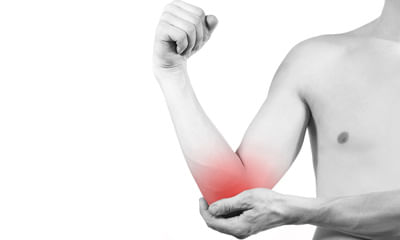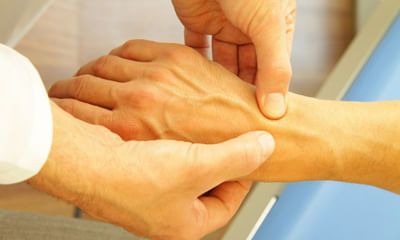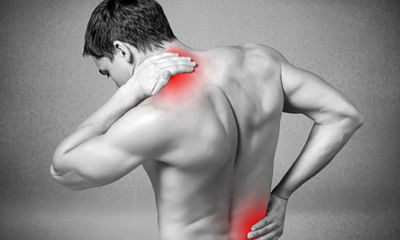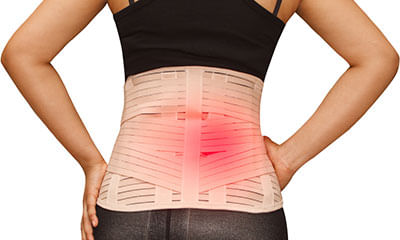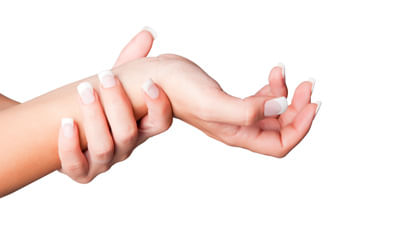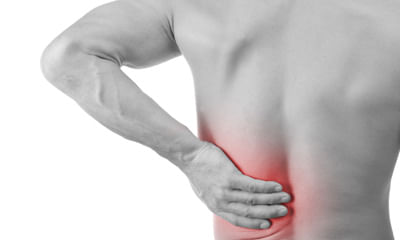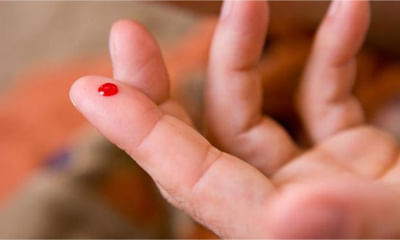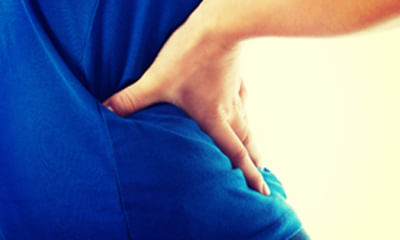Tingling Feeling In Right Arm And Hand
I am feeling pain in different part of right hand alongwitg tingling since last one month and took Vitamin B tablet on a ...
Ask Free Question
Do contrast bath therapy for hand & fingers Do ball squeezing activity multiple times a day Do hand & arm stretches Do dough making activity
I am feeling uneasy in my left hand finger. I am not getting pain but its like its getting numb. Finger is working but s ...
Ask Free Question
If your symptoms had been in the The first three digits of a hand, it could be carpal tunnel syndrome- a pinched nerve in your wrist. If the symptoms are in last 2 digits of the hand, it could a different type of pinched nerve. If numbness and tingling is in whole hand- it could be neuropathy. If numbness in fingers is associated with neck pain and radiating pain in arm- it could be a pinched nerve in your cervical spine. So based on the information you share, it is hard to draw any conclusions about what you have.
I am 23 year male and before few month pull up dumbbell for few days and after that have pain in shoulder and tingling i ...
Ask Free Question
Probably it's some strain,sprain or tendinitis which should be examined for by orthopedic doctor.support arm in sling and avoid weight lifting or other exercises until you get yourself checked up.
After my spinal surgery (Interlaminar micro-lumber disectomy) two month back. I was feeling tingling in left arm, I had ...
Ask Free Question
Hi You are on right medicine.just try some local massage, vivaran gel application of affected area and neck, hot fomentation and neurobion forte once daily
I am 50 years old left hand fingers are feeling numb from 6 to 7 hours what should I do? ...
Ask Free Question
Pressure upon the arm nerves or vessels causing numbness, tingling or temporary paralysis of the arm may result from: Sleeping with the hand under the head Sitting with the arm hanging over the back of a chair Wearing straps or carrying a bag or rucksack Inflated cuff during measuring blood pressure Raising the Arms Above the Level of the Heart Keeping the hand (s) above the level of the heart during work or sleep can prevent appropriate blood perfusion of the hands, and cause numbness, tingling or partial paralysis of the hand (s) within few minutes. Cold In cold weather, narrowing of the arteries in the hands and fingers can prevent appropriate blood supply and thus numbness, tingling, pain or temporary paralysis of the hands and fingers. DISORDERS OF THE NECK (CERVICAL) SPINE Cervical Disk Syndrome Degenerative disc disease (DDD) or injury, like hyper-extension injury in car accidents (head moves rapidly toward the back), can result in bulging or herniated disc (s) pressing upon the cervical (neck) spinal nerves, thus causing symptoms of cervical disc syndrome: Position/movement dependent pain, tingling or numbness in the neck, shoulders, upper back, arm, hand or fingers (when the roots of cervical spinal nerves are compressed) Stumbling gait, difficulty with fine hand moves, tingling in the body or legs (when the cervical spinal cord is compressed) Symptoms can appear immediately after the injury, or develop slowly over the weeks or months. Diagnosis is made by a CT or MRI of the neck spine. Therapy includes immobilization, cold therapy followed by heat therapy, cervical traction, analgesics, muscle relaxants, physical therapy or surgical decompression of the nerve roots or spinal cord. Cervical Spondylosis Cervical spondylosis is an age-related deformation of the cervical spine; deformed vertebra or discs can press upon the spinal cord or nerve roots in the neck and cause chronic symptoms, like in the cervical disc syndrome (see above). INJURIES Disorders of the Brachial Plexus The brachial plexus is formed by the cervical nerves C5-C8 and thoracic nerve Th1. The plexus extends from the lower part of the neck to the armpit. From brachial plexus all main nerves to the arm (axillary, musculocutaneus, ulnar, radial, and median nerve) arise. Brachial Plexus Injuries Most of brachial plexus injuries usually occur in car, motorcycle and sport accidents, during birth, or in bullet or knife injuries. Symptoms and prognosis depend on the nerves involved and extent of an injury: nerve stretching, scar tissue (neuroma), partial or complete nerve rupture or tearing of the nerve from the spinal cord. A limp or paralyzed arm, severe pain and numbness, especially in the neck and shoulders, and weak arterial pulses in the arm are main symptoms. Some brachial plexus injuries may heal without treatment. Many children who are injured during birth improve or recover by 3 to 4 months of age. Treatment of brachial plexus injuries includes physical therapy and, if necessary, surgery. Thoracic Outlet Syndrome Thoracic outlet is the space between the collar bone (clavicle), first rib and corresponding ligaments through which nerves and vessels travel from the base of the neck toward the armpit. Thoracic outlet syndrome (TOS) results from a compression or extension of the subclavian artery or vein, or brachial plexus (nerves), commonly occurring in motorbike accidents, athletes, swimmers, weight lifters, etc. Symptoms include: Muscle wasting at the base of the thumb, numbness, feeling of pins and needles, or pain in the shoulder, armpit, arm or hand (when nerves are compressed) Pale, cool arm with weakened arterial pulse in the arm, numbness and pain (when vessels are compressed) Radiation-Induced Brachial Plexopathy Radiation-induced damage of the brachial plexus can follow radiotherapy of the chest, axillary region, thoracic outlet or neck. Symptoms may appear months to years after radiation therapy and include numbness, swelling, weakness or pain in the arm. Broken Shoulder Blade Shoulder blade (scapula) is the bone in the upper back that connects the collar bone (clavicle) and arm bone (humerus). Broken shoulder blade, usually from a car or motorbike accident, can result in pain, swelling, bruising or deformation of the shoulder blade area, and weakness, numbness or tingling in the shoulder or arm. Broken Arm, Wrist, Hand or Finger Symptoms of broken arm (the arm bone â humerus, elbow, and bones of the forearm â radius and ulna) include: Severe pain increasing with arm movement Obvious deformity, swelling, tenderness and bruising over the site of bone fracture Stiffness or inability to move your arm, hand or finger Weakness, numbness or tingling in the arm, hand or fingers Cubital Tunnel Syndrome or Ulnar Neuropathy The ulnar nerve arises from the brachial plexus in the neck and travels under the collar bone, downside along the inner side of the upper arm, behind the inner part of the elbow (Latin cubitus), where it can be felt as a âfunny boneâ and then down to the wrist, hand and little and ring finger. Ulnar nerve entrapment usually results from an elbow injury or constant pressure upon the elbow, like in cyclists or typists. Symptoms, known as cubital tunnel syndrome, include: Pain on the inner side of the elbow or electric shock sensation after touching the elbow The hand, ring and little finger are numb and falling asleep, especially after bending the elbow Limited movements of the ring and little finger (âhandlebar palsyâ in cyclists) Hand (on the little finger side) sensitivity to cold Prevention of ulnar nerve entrapment is by avoiding excessive elbow use. Treatment includes special arm exercises, anti-inflammatory drugs, like ibuprofen, and wearing an elbow splint. DISORDERS OF THE SPINAL CORD AND BRAIN Multiple Sclerosis Multiple sclerosis is a disease of an uncertain cause affecting the nerve tissue of the spinal cord, brainstem or brain. Symptoms can appear suddenly or gradually, âtravelâ among various body parts and include: numbness or tingling in one or both arms (or any other body part), blurred or double vision or blindness, weak or paralysed limbs, problems with urinating or defecating, difficulty maintaining balance, tiredness, etc. Symptoms can last from few weeks to several months, disappear completely and appear again, and, in general, worsen with time. Diagnosis is with MRI of the brain and spinal cord, and examination of cerebrospinal fluid obtained by lumbar punction. Apart from treating symptoms, there is no treatment for multiple sclerosis at the time. ACUTE BRACHIAL NEURITIS Acute brachial neuritis is a rare, supposedly autoimmune inflammation of brachial plexus, occurring at any age, but primarily in young men. Symptoms include severe pain in the upper arms and shoulders, followed by numbness and weak reflexes; the disorder resolves in few months on its own. WRIST DISORDERS Carpal Tunnel Syndrome (CTS) Carpal tunnel syndrome (Latin carpus = wrist) is a painful condition of the wrist, hand and fingers, caused by repetitive use of the wrist, or swelling of the tissues in the wrist, resulting in a pressure upon the median nerve. CTS is a common problem in assembly line workers, computer workers, musicians, mechanics, tennis players, etc. Bone spurs in rheumatoid arthritis, or fluid in hypothyroidism, kidney disease or menopause may also press on the median nerve. Symptoms usually start gradually and include: Tingling or numbness in the thumb, index, middle and ring finger and related part of the hand Pain in the wrist, palm or forearm Difficulty grasping small objects or gripping Hand pain at night Ganglion Cyst Ganglion cyst (Greek ganglion = tumor, cyst = fluid filled sac) is a soft lump, usually appearing on the back of the hand in some people between 20-40 years of age. It is a noncancerous fluid filled sack arising from the tendon sheets or capsule of the joint from an unknown reason. Ganglion cysts may not be always seen from the outside. Gymnasts often have them. Symptoms include: A soft lump or lumps of various size (may exceed an inch), on the back of the hand, inner side of the wrist, base of the finger, or on the last finger joint. Pain or numbness in the wrist, hand or finger (s) DISORDERS OF FINGER ARTERIES Raynaudâs Disease Raynaudâs disease is a painful finger condition due to spasms in the finger arteries. Disease may also affect toes or, rarely, nose, ears, lips and nipples. The cause is not known. Symptoms are triggered by cold (even short term cold like taking something from a freezer) or strong emotions, and appear in the following sequence: Fingers (one, more or all in one or both hands) become pale, numb or cold due to lack of blood flow, then bluish due to a lack of oxygen, then red, with throbbing pain and tingling as blood returns to the affected area. Attacks can occur daily, weekly or occasionally and can last from less than a minute to several hours, usually about 15 minutes. Different areas can be affected at different times. Severe, although rare, attacks can result in finger sores or tissue death (gangrene). Raynaudâs Phenomenon Raynaudâs phenomenon is a term used for the same finger symptoms as in Raynaudâs disease, when the cause is known. Causes include: connective tissue diseases, like scleroderma, systemic lupus erythematosus (SLE), Sjögrenâs syndrome, dermatomyositis, and polymyositis, carpal tunnel syndrome, obstructive arterial disease, anti-hypertensive drugs, ergotamine (used for treating migraine), chemotherapeutic medications, etc. In workers exposed to vinyl chloride, using vibrating tools, typists and pianists, Raynaudâs phenomenon also commonly occurs. DIAGNOSIS OF ARM NUMBNESS OR TINGLING History of arm numbness. Knowing an exact time course of tingling or numbness, and eventual arm weakness, head or legs involvement, history of arm or neck injuries, repetitive elbow or wrist use, reactions to cold, hypothyroidism, diabetes, menopause may give a strong evidence about the cause. Neurological examination. Testing of sensitivity of a particular arm dermatome can reveal which nerves are involved. Imaging. X-ray may reveal arthritis in the neck spine, or a broken arm bone. Myelography can reveal herniated disc or narrowed spinal canal. MRI and CT show soft tissues like tumors. Electromiography (EMG) and nerve conduction studies can show the nature of the nerve damage. Together with imaging they are important to evaluate the extent of brachial plexus injury. Blood tests can reveal diabetes, abnormalities in serum levels of sugar (diabetes), calcium, potassium, sodium, magnesium, vitamins B6 or B12, thyroxine (hypothyroidism), sex hormones (menopause). Cold simulation test can reveal Raynaudâs disease or phenomenon. TREATMENT OF ARM NUMBNESS OR TINGLING Firstly, the cause of numbness should be treated if possible. Non-steroid anti-rheumatic drugs like ibuprofen, or antidepressants, may relieve pain and numbness.
Hi I 'm 33 years old male from last 3-4 months initial had been facing issue related to muscular pain in legs + upper/mi ...
Ask Free Question
Apply hot fomentation twice daily. Avoid bending in front. Postural correction- sit tall, walk tall. Extension exercises x 15 times x twice daily - lying on tummy, take left arm up for 3 seconds, then bring it down, right arm up for 3 seconds, bring down. Bring right leg up, hold for 3 seconds, bring it down. Then right leg up and hold for 3 seconds and bring it down. Repeat twice a day- 10 times. Bhujang asana -- lie flat on your stomach, keeping the palms out, bend the neck backward, take a deep breath and while holding it for 6 seconds, raise the chest up. Release breath and relax your body. Repeat the exercise 15 times twice daily. Core strengthening exercises- straight leg raised with toes turned outward, repeat 10 times, twice a day.
How to differentiate whether low sugar or high sugar? What precautions to be taken? What are the remedies? ...
Ask Free Question
One has to check blood sugar to find out if he or she has low or high sugar. If a person has been diagnosed to have diabetes, means his blood sugar is higher than normal. High blood sugar can only be detected by testing the blood, because it hardly produces any specific symptoms unless the levels have really gone very high. Low blood sugar (hypoglycemia) can occur in a patient on treatment for diabetes, who may had not taken adequate food, or there may be delay in taking food after taking tablets or insulin or dose may have been high. This causes drop in blood sugar. When it goes below 6o to 70 mg/100 ml, the person starts feeling uneasy, may get blurred vision, feeling of weakness, shivering, sweating, giddiness, hungry and at times black out. For treating high sugar one has to take anti diabetes drugs. To treat hypoglycemia one should be given glucose immediately.
My left hand left shoulder & left leg are getting freeze with mild pain. I am feeling heavy chest (left side). Mild pain ...
Ask Free Question
Hello, this type of pain is may be because of cervical herniated disc. The material in between cervical vertebrae" pinches" or presses on a cervical nerve, causing pain to radiate along the nerve pathway down the arm. Along with the arm pain, numbness and tingling can be present down the arm and into the fingertips. Muscle weakness may also be present due to a cervical herniated disc. You can follow these advise till you aren't sending me the detailed history and your all investigation report:- 1. Avoid heavy lifting. 2. Have balanced diet which is rich in calcium contents. 3. Have sun bath daily, to prevent further damage. I'll teach you each and every exercise, do's and don'ts after diagnose you briefly. Thanks.
If i am smoking cigratte so swine flu will harm me or not! because some where i had read that while smoking the person ...
Ask Free Question
No. Stop smoking Dr. Aravinda jawali pharmacological treatments to help quit smoking why is it so hard to quit smoking? you have probably heard this before" smoking is so bad for you. Why do you do it" people start smoking for different reasons. They might think it will help calm their nerves, make them look more mature, or maybe at the time it just seemed sort of adventurous. Looking back, it was not the best choice. Many people really want to quit, but why is quitting so hard? it is hard to quit smoking because the nicotine in cigarettes, cigars, and other tobacco products gets you hooked and keeps you hooked. Most people try as many as three times to quit before they are able to do so. Look at smoking cessation as a process instead of a one-time event. That way, if you do slip, you can focus on what you can do differently to prevent future slips and relapse. Don? t give up? you will get there. You have probably heard a lot about how smoking is harmful, but here are some positive things you can look forward to when you do quit. If you quit, you will: prolong your life improve your health feel healthier (smoking can cause coughing, poor athletic ability, and sore throats.) look better (smoking can cause face wrinkles, stained teeth, and dull skin.) improve your sense of taste and smell save money (most smokers spend about $90 a month on cigarettes.) smoking increases complications for those who have diabetes. While smoking can increase your chances of getting diabetes, it can also make managing diabetes more difficult for those who already have it. Smoking-related complications of diabetes could include retinopathy (eye disease), heart disease, stroke, vascular disease, kidney disease, nerve damage, and/or foot problems. What options do people have? some people try quitting on their own before they go to their doctor, but your doctor can be very helpful. He or she may offer tips and suggest medicines, both prescription and over-the-counter, to help you" kick the habit" it is also important to tell your doctor what types of products you might use or are using to quit smoking. The doctor can make sure that suggested products will not interact with other medicines you are already taking. Remember, there is no" magic bullet" when it comes to quitting smoking. Quitting requires persistent effort. Over-the-counter medicines nicotine-based medicines over-the-counter medicines that contain nicotine can be very helpful in fighting off cravings. These products will not remove all cravings, but you can use them instead of smoking to reduce your nicotine intake gradually and ease off of its addictive effects. When you give your body a steady dose of nicotine all the time and then stop suddenly, you will have more side effects (withdrawal symptoms) that usually make quitting a lot harder. Withdrawal symptoms include irritability, headache, and the craving to smoke. Go slow and lower the dose gradually with nicotine-based products until you feel you are able to resist the cravings on your own. You will still have cravings, but they will be weaker. It is very important to have some form of social support when you decide to quit, no matter if you use products or not. Support can come from your doctor, counselor, support group, close friend, or a family member. When considering a nicotine-based product to help you quit, be sure to tell your doctor about any conditions you might have, especially: asthma or breathing problems heart or blood vessel disease high blood pressure stomach ulcer diabetes mellitus kidney disease liver disease overactive thyroid pheochromocytoma (pcc) over-the-counter treatments are typically used for up to 12 weeks as part of a smoking cessation program. Additional things to consider when taking nicotine-based medicines do not smoke while you are using the nicotine-based medicines. You could risk overdosing on nicotine. Tell your doctor about any medicines you are taking or any allergies you have. Do not use the nicotine-based medicines if you are breastfeeding, are pregnant, or think you might be pregnant. Keep this and all medicines out of the reach of children and pets. Common brand names of the nicotine patch, gum, and lozenge include: nicorelief (gum) nicorette (gum) nicoderm cq (patch) commit (lozenge) transdermal nicotine patch the patch is worn directly on the skin. Nicotine passes through the skin into your bloodstream. Some brands have patches with different strengths so you can gradually reduce your dosage. Nicotine patches are available without a prescription. If you are not sure what kind of patch to use, ask your doctor. Always follow the instructions on the box, but here are some things to remember when using the nicotine patch: patches are supplied in child-resistant pouches; save the pouch for disposal of the patch. Find a clean, dry part of the skin to apply it. Somewhere on your upper arm or torso usually works best. Try to find an area that has little hair and is without scars, cuts, burns, or rashes. Right before applying the patch, wash your hands and the skin area with plain soap and water and dry completely. Avoid using any soap, lotion, hand cream, tanning lotion or oil, bath oil or insect repellent that contains aloe, lanolin or glycerin as a moisturizer since these agents can leave a moisturizing film on your skin, which can potentially interfere with the adherence of the patch. When you have finished applying or removing the patch, wash your hands with water only. Do not try to adjust the dosage by cutting the patch into sections. Leave the patch on, even while bathing or swimming. If it falls off, do not try to re-apply it. Use a new one remove the patch according to the instructions on the box (usually after 16 to 24 hours). Dispose by folding sticky ends of the patch together and putting in pouch. When applying a new patch, choose a different place than before. Do not use the patch in the same place for at least a week. Do not leave the patch on for longer than directed. Remove the patch if you are going to do rigorous exercise. This might cause more nicotine to pass into your bloodstream. If you are unsure how to use the product, be sure to ask your doctor or pharmacist to explain. Remove the patch if you are having a magnetic resonance imaging (mri) scan. Nicotine patches contain aluminum. If you have vivid dreams or other sleep disturbances, try removing the patch at bedtime and applying a new one in the morning. Common side effects of the nicotine patch: increased appetite mild headache irritation at the site of the patch, including itching, burning, or redness there are other common or more serious side effects. Please read the information that comes with the product carefully, and be sure to contact your doctor if you have any questions. Nicotine gum nicotine gum, like the patch, is a systemic way to receive nicotine. This means that the nicotine in the gum passes from the lining of your mouth right into your bloodstream. Like the patch, you will decrease the dosage during the recommended time (usually 12 weeks or sooner) if you are able to resist cravings on your own. Nicotine gum is sold without a prescription. Always follow the instructions on the box, but here are some things to remember when using nicotine gum: use nicotine gum only when you feel the urge to smoke. Slowly chew the gum until you begin to taste it or feel a tingling sensation in your mouth. Then stop chewing and park it between your cheek and gum. This helps release the nicotine. When the taste or tingling is almost gone, repeat these two steps for 30 minutes. Use only one piece at a time. Do not drink beverages (e. G, soft drinks, tea, coffee, and fruit juices) or eat food 15 minutes before or while chewing the gum. Gradually decrease the number of pieces of gum you chew per day, until you reach three to six pieces per day. Some people can do this in less than 12 weeks. Do not chew more than twenty-four pieces in 1 day. Try to have the nicotine gum handy at all times. You might try hard candy or using regular gum, if the nicotine gum is not available. Nicotine gum can be difficult to use if you have dentures. Common side effects of nicotine gum: belching (burping), gas, or heartburn increased appetite mild headache watery mouth jaw or muscle pain or fatigue sore mouth or throat nausea hiccups there are other common or more serious side effects. Please read the information that comes with the product carefully and be sure to contact your doctor if you have any questions. Nicotine lozenge a nicotine lozenge, like the patch and gum, is a systemic way to receive nicotine. This means that the nicotine in the lozenge passes from the lining of your mouth right into your bloodstream. Always follow the instructions on the box, but here are a few things to remember when using the nicotine lozenges: place the lozenge in your mouth; wait until it dissolves completely; and move it around from time to time without chewing. It takes around 20 to 30 minutes to dissolve. Do not take more than one lozenge at a time or continuously use one lozenge after the other, this can cause hiccups, heartburn, or nausea. Do not eat or drink 15 minutes prior to, during, or after use. Do not use more than five lozenges in 6 hours or more than twenty lozenges in 24 hours. Prescription medicines nicotine nasal spray nicotine that can help you stop smoking also comes in the form of a nasal spray, available only by prescription. Like the patch and the gum, the amount taken is gradually decreased during a period of 12 weeks. It is to be used, like the gum and the patch, as part of a program that also includes support, education, and counseling. Nicotrol ns is one brand of nicotine nasal spray. Always follow the instructions on the prescription label. Here are some other things to remember when using nicotine nasal spray: blow your nose prior to use. You may gradually reduce your dose of nasal spray by skipping doses or using only half the usual amount. Writing down the time you take the nasal spray and how much you take might be very useful when reducing your dose. Common side effects of nicotine nasal spray: back pain constipation coughing indigestion or nausea runny nose sneezing watery eyes headache a burning feeling in the back of the throat or nose the nicotine nasal spray is not recommended for people with reactive airway disorders such as asthma. In addition, caution is urged in patients with chronic nasal disorders. There are other common or more serious side effects. Please read the information that comes with the product carefully and be sure to contact your doctor if you have any questions. Nicotine inhalant a nicotine inhalant? available only by prescription? used for up to 6 months (initial treatment period up to 12 weeks followed by gradual reduction period of up to 12 weeks) can be part of a smoking cessation program. When the inhaler is used, nicotine passes from the lining of the mouth and throat (not the lungs) into the bloodstream. Like other nicotine products, you will decrease the dosage during the recommended time (usually several weeks) or until you are able to resist cravings on your own. Nicotrol inhaler is one brand name of nicotine inhalant. Always follow the instructions on the box, but here are some things to remember when using a nicotine inhalant: store the inhaler in a dry area at room temperature not to exceed 77 f or 25 c. Write down the time you take the inhalant and how much you take. This might be very useful when reducing your dose. The normal first dose is between six and sixteen cartridges per day. Common side effects of nicotine inhalants: coughing indigestion mouth and throat irritation stuffy nose or runny nose there are other common or more serious side effects. Please read the information that comes with the product carefully and be sure to contact your doctor if you have any questions. Bupropion bupropion is more commonly seen under the brand names of zyban or wellbutrin. Zyban is specifically indicated for smoking cessation. It is not a nicotine-based medicine; it is an antidepressant that is only available by prescription. It is prescribed along with counseling and support to aid in smoking cessation. Bupropion might also be used to treat major depressive disorders. It usually takes 2 weeks for bupropion to take effect, so plan to quit smoking 2 weeks after beginning the treatment. Before considering bupropion, be sure to inform your physician if you have a history of seizure disorder, bulimia, or anorexia nervosa. Bupropion comes in tablets that are to be swallowed whole, not crushed, divided, or altered in any other way. Individual prescription strengths might vary, so if you are taking bupropion, be sure to follow the directions on the label. Ask your doctor or pharmacist any questions you have about how to take it, when to take it, any potential side effects, and the duration of treatment. Common side effects of bupropion: dry mouth sweating insomnia rash headache dizziness anxiety restlessness irritability indigestion decreased appetite there are other common or more serious side effects. Please read the medication guide that comes with the product carefully and be sure to contact your doctor if you have any questions. Do not take bupropion if you have taken a monoamine oxidase inhibitor (maoi) within the last 14 days. Monoamine oxidase inhibitors are used to treat depression. Some examples include: tranylcypromine (parnate), phenelzine (nardil), and isocarboxazid (marplan). There are several products that might interact with bupropion, so be sure to tell your doctor about any over-the-counter and/or prescription medicines, as well as any herbal supplements you are taking. While taking bupropion, immediately report any psychological changes (e. G, new onset depression) to your doctor. Varenicline (chantix) varenicline, also known by the brand name chantix, is a prescription medication that does not contain nicotine. This medicine helps to reduce the reinforcing effects of nicotine and can minimize the withdrawal effects from nicotine. It is recommended to set a quit date 1 week after initiation of varenicline therapy. Typically, this medication is taken for a minimum of 12 weeks accompanied by smoking cessation counseling. If you have stopped smoking, another 12 weeks of varenicline might be prescribed. If you have not stopped smoking after the first 12 weeks, stop taking this medication and return to your doctor for advice. Varenicline should be taken with food and a full glass (8 ounces) of water. Varenicline can interact with over-the-counter and prescription medicines especially insulin, blood thinners, and asthma medications as well as with certain herbal supplements; therefore, it would be important to inform your physician of your entire medication regimen. Contact your doctor immediately if you experience any psychological changes (e. G, new onset depression) while taking varenicline. Common side effects of varenicline: nausea, which may dissipate over time headache insomnia there are other common or more serious side effects. Please read the medication guide that comes with the product carefully and be sure to contact your doctor if you have any questions. How could research benefit smokers who want to quit? researchers are testing a vaccine that could make quitting a lot less difficult. This type of treatment could potentially be used in a program, along with bupropion (zyban) and counseling, to significantly reduce withdrawal symptoms.

